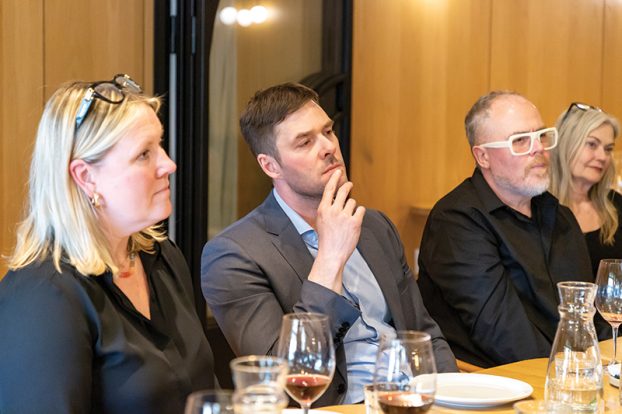When Paul Chater and Jim Kabrajee purchased 45-year-old communications firm Marshall Fenn, they had a long-term vision in mind: creating a strategically-driven, integrated, full-service agency of the future. But after checking out their recent work with Casino Rama, KPMG or The Greater Toronto Marketing Alliance, you might say the future is now. And now, as part of Microforum Inc., they have added the latest in technological communication and marketing.
When discussing how they go about developing communications strategies for their clients, Kabrajee and Chater say they begin by distilling the corporate objectives, dreams and desires of the client, then determine where, within the market, they will be in the long term. ‘This point on the horizon is our starting point; from here we work backwards,’ says Chater.
According to Kabrajee, ‘Once we know where we are headed, we begin to assess all the factors that will have an impact on our clients’ progress toward this point; competition, technology, internal resources, capital markets, consumer trends, changing population demographics all act as forces on the client’s ability to get to where they need to be. Armed with this information we can develop a communications strategy that gets us where we need to go as efficiently as possible.’
This is where being a truly integrated communications company makes the difference for Marshall Fenn. As marketers who understand Advertising, Public Relations and Interactive first hand, they are able to formulate and execute strategies that encompass all aspects of the communications spectrum.
‘If you ask the presidents of an ad agency, a public relations firm, or an Internet marketer about the future, they’ll each pitch a particular point of view,’ says Kabrajee. ‘As a client, you have to consider those different views and determine who is right – or whether the answer exists somewhere in between. Because we offer a complete spectrum of marketing capabilities, integrated vision is resident under one umbrella.’
At Marshall Fenn, the principals are experienced
marketing generalists, but each has a marketing specialty as well: Chater in public relations, Kabrajee in advertising and Microforum’s experts in interactive. It’s a powerful, synergistic combination that they consider one of their major assets.
‘Because we each have mutual respect for the results that all marketing disciplines can achieve, we can approach clients’ needs from a truly unbiased perspective,’ says Chater. ‘We’re capable of objectively assessing their problems and opportunities from a strategic standpoint, offering an integrated communications solution – not necessarily just an advertising, PR or Internet solution. We also recognize that clients’ overworked, down-sized marketing departments would be better served by working with one integrated agency rather than three or four with differing points of view.’
Although many agencies call themselves integrated, very few really are, according to Chater. ‘There’s competition within those agencies for turf and squabbles for the client’s budget and therefore the client really isn’t receiving an integrated solution.’
The only way an agency can truly integrate is by removing potential barriers and points of separation that have traditionally existed between advertising, public relations and interactive professionals, observes Kabrajee. ‘Here at Marshall Fenn, these disciplines are constantly brought together in brain storming exercises where staffers provide diverse viewpoints but also get an opportunity to learn the strategies and views of someone from another communications discipline.’
The result is a well-educated group of people with understanding and respect for different communications strategies, and the client becomes the beneficiary of a comprehensive and tight strategy. Kabrajee and Chater even integrated the office space. PR people, ad people and interactive people literally have offices next door to each other. There are no mental or physical divisions.
Marshall Fenn finds itself in a unique position in the industry: not simply observers of new technology trends and capabilities, but along with their sister company Microforum, they are a leading-edge driver of them.
‘We actually have the ability to influence where the future is going, because Microforum is bringing the new interactive technology to market and we’re involved with it on a daily basis,’ says Chater.
‘Microforum recently sold a high-end E-commerce package to Sony Music Canada for their online music store. Not many agencies can make that claim. Most are behind or simply on the learning curve; we’re actually defining it.’
Because Marshall Fenn was pushing the Internet as a marketing tool as far back as 1994, they have always been a little bit ahead of the curve, adds Kabrajee.
Kabrajee admits that ‘such a unique approach comes at a cost – investing an enormous amount of non-revenue time and brainpower into understanding technology, trends and market factors is expensive, but it allows us to counsel clients on which bandwagon to jump on and which to avoid.’
‘We’re working in a bizarre world because for the first time, technology is really driving needs as opposed to the other way around,’ he says. ‘As technology evolves, somebody finds a need for it. That flies in the face of the marketing paradigm – first find a need.’
Chater believes that many agencies and clients don’t recognize that along with the many positive benefits technology brings, there is a negative side. Today, through e-mail, rumours and misinformation now circulate the globe in a matter of seconds, stoking a huge potential for public relations crises.
‘Ten years ago, you could take time and counteract a negative rumour early on, but now an incorrect public perception of a product can go global in minutes,’ he observes. ‘Knowing this and how it develops is one part of the thinking that goes into developing counter strategies for our clients.’
Today, there are more environmental, regulatory, technological and competitive factors affecting a client’s progress toward that distant point than ever before, ‘If you are simply reacting at any given moment, then it’s going to take you a long time to get there. You may eventually reach your goal, but you’ll get there the hard and expensive way,’ says Kabrajee.
That’s why Marshall Fenn always keeps that far point on the horizon firmly fixed in their sights, knowing where the client is heading and leading them through and around the patches of turbulence that would distract and buffet them along the way.
Marshall Fenn Communications
1246 Yonge Street
Suite 300
Toronto, Ontario
M4T 1W5
Tel: 416 962.3241
Fax: 416 962.6459
e-mail: paul@marshall-fenn.com
web: www.marshall-fenn.com
Also in this sponsored supplement:
– Using insight to incite consumer behaviour p.SA1
– Due North Communications: Our aim is true p.SA2
– Bates Canada: The importance of having a sense of theatre p.SA3
– Carlson Marketing Group: Building clients’ businesses one relationship at a time p.SA4
– Cundari Group: Proven bench strength p.SA7
– Maritz Canada: Leveraging brands through sales channel performance p.SA8
– War Paint Brand Directions: Marketing is about out-thinking your competition. Isn’t it? p.SA9
– Rapp Collins Communicaide: Where data builds brands p.SA11
– Enterprise Creative Selling: Building a model agency p.SA12























